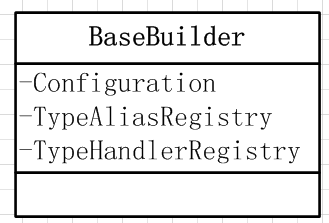元素设置
继续MyBatis的Configuration加载源码分析:
1 private void parseConfiguration(XNode root) { 2 try { 3 Properties settings = settingsAsPropertiess(root.evalNode("settings")); 4 //issue #117 read properties first 5 propertiesElement(root.evalNode("properties")); 6 loadCustomVfs(settings); 7 typeAliasesElement(root.evalNode("typeAliases")); 8 pluginElement(root.evalNode("plugins")); 9 objectFactoryElement(root.evalNode("objectFactory")); 10 objectWrapperFactoryElement(root.evalNode("objectWrapperFactory")); 11 reflectorFactoryElement(root.evalNode("reflectorFactory")); 12 settingsElement(settings); 13 // read it after objectFactory and objectWrapperFactory issue #631 14 environmentsElement(root.evalNode("environments")); 15 databaseIdProviderElement(root.evalNode("databaseIdProvider")); 16 typeHandlerElement(root.evalNode("typeHandlers")); 17 mapperElement(root.evalNode("mappers")); 18 } catch (Exception e) { 19 throw new BuilderException("Error parsing SQL Mapper Configuration. Cause: " + e, e); 20 } 21 }
上回看到了第7行的
现在先看一下元素设置的代码,即第12行的settingsElement方法:
1 private void settingsElement(Properties props) throws Exception { 2 configuration.setAutoMappingBehavior(AutoMappingBehavior.valueOf(props.getProperty("autoMappingBehavior", "PARTIAL"))); 3 configuration.setAutoMappingUnknownColumnBehavior(AutoMappingUnknownColumnBehavior.valueOf(props.getProperty("autoMappingUnknownColumnBehavior", "NONE"))); 4 configuration.setCacheEnabled(booleanValueOf(props.getProperty("cacheEnabled"), true)); 5 configuration.setProxyFactory((ProxyFactory) createInstance(props.getProperty("proxyFactory"))); 6 configuration.setLazyLoadingEnabled(booleanValueOf(props.getProperty("lazyLoadingEnabled"), false)); 7 configuration.setAggressiveLazyLoading(booleanValueOf(props.getProperty("aggressiveLazyLoading"), true)); 8 configuration.setMultipleResultSetsEnabled(booleanValueOf(props.getProperty("multipleResultSetsEnabled"), true)); 9 configuration.setUseColumnLabel(booleanValueOf(props.getProperty("useColumnLabel"), true)); 10 configuration.setUseGeneratedKeys(booleanValueOf(props.getProperty("useGeneratedKeys"), false)); 11 configuration.setDefaultExecutorType(ExecutorType.valueOf(props.getProperty("defaultExecutorType", "SIMPLE"))); 12 configuration.setDefaultStatementTimeout(integerValueOf(props.getProperty("defaultStatementTimeout"), null)); 13 configuration.setDefaultFetchSize(integerValueOf(props.getProperty("defaultFetchSize"), null)); 14 configuration.setMapUnderscoreToCamelCase(booleanValueOf(props.getProperty("mapUnderscoreToCamelCase"), false)); 15 configuration.setSafeRowBoundsEnabled(booleanValueOf(props.getProperty("safeRowBoundsEnabled"), false)); 16 configuration.setLocalCacheScope(LocalCacheScope.valueOf(props.getProperty("localCacheScope", "SESSION"))); 17 configuration.setJdbcTypeForNull(JdbcType.valueOf(props.getProperty("jdbcTypeForNull", "OTHER"))); 18 configuration.setLazyLoadTriggerMethods(stringSetValueOf(props.getProperty("lazyLoadTriggerMethods"), "equals,clone,hashCode,toString")); 19 configuration.setSafeResultHandlerEnabled(booleanValueOf(props.getProperty("safeResultHandlerEnabled"), true)); 20 configuration.setDefaultScriptingLanguage(resolveClass(props.getProperty("defaultScriptingLanguage"))); 21 configuration.setCallSettersOnNulls(booleanValueOf(props.getProperty("callSettersOnNulls"), false)); 22 configuration.setUseActualParamName(booleanValueOf(props.getProperty("useActualParamName"), false)); 23 configuration.setLogPrefix(props.getProperty("logPrefix")); 24 @SuppressWarnings("unchecked") 25 Classextends Log> logImpl = (Classextends Log>)resolveClass(props.getProperty("logImpl")); 26 configuration.setLogImpl(logImpl); 27 configuration.setConfigurationFactory(resolveClass(props.getProperty("configurationFactory"))); 28 }
看到这个方法的实现主要就是将之前解析出来的
environments加载
接着就是
1 private void environmentsElement(XNode context) throws Exception { 2 if (context != null) { 3 if (environment == null) { 4 environment = context.getStringAttribute("default"); 5 } 6 for (XNode child : context.getChildren()) { 7 String id = child.getStringAttribute("id"); 8 if (isSpecifiedEnvironment(id)) { 9 TransactionFactory txFactory = transactionManagerElement(child.evalNode("transactionManager")); 10 DataSourceFactory dsFactory = dataSourceElement(child.evalNode("dataSource")); 11 DataSource dataSource = dsFactory.getDataSource(); 12 Environment.Builder environmentBuilder = new Environment.Builder(id) 13 .transactionFactory(txFactory) 14 .dataSource(dataSource); 15 configuration.setEnvironment(environmentBuilder.build()); 16 } 17 } 18 } 19 }
第3行~第5行的代码,得到默认的JDBC环境名称。
第6行的代码开始遍历
- 源码并没有对不满足第8行判断即不是默认
的场景做判断,因此可以得到一个结论: 标签下的default属性是一个必填属性 。 - 即使配置再多的
标签,MyBatis只会加载其中的一个
第9行的代码根据
第10行的代码和第9行的代码差不多,根据
第11行的代码根据DataSourceFactory获取DataSource,在MyBatis中根据配置分三种场景:
- PooledDataSourceFactory对应的DataSource是PooledDataSource
- UnpooledDataSourceFactory对应的DataSource是UnpooledDataSource
- JndiDataSourceFactory对应的DataSource要去JNDI服务上去找
第12行~第15行的代码比较简单,根据TransactionFactory和DataSource创建一个Environment并设置到Configuration。
mapper加载
config.xml中两个最重要的标签,一个是
1 private void mapperElement(XNode parent) throws Exception { 2 if (parent != null) { 3 for (XNode child : parent.getChildren()) { 4 if ("package".equals(child.getName())) { 5 String mapperPackage = child.getStringAttribute("name"); 6 configuration.addMappers(mapperPackage); 7 } else { 8 String resource = child.getStringAttribute("resource"); 9 String url = child.getStringAttribute("url"); 10 String mapperClass = child.getStringAttribute("class"); 11 if (resource != null && url == null && mapperClass == null) { 12 ErrorContext.instance().resource(resource); 13 InputStream inputStream = Resources.getResourceAsStream(resource); 14 XMLMapperBuilder mapperParser = new XMLMapperBuilder(inputStream, configuration, resource, configuration.getSqlFragments()); 15 mapperParser.parse(); 16 } else if (resource == null && url != null && mapperClass == null) { 17 ErrorContext.instance().resource(url); 18 InputStream inputStream = Resources.getUrlAsStream(url); 19 XMLMapperBuilder mapperParser = new XMLMapperBuilder(inputStream, configuration, url, configuration.getSqlFragments()); 20 mapperParser.parse(); 21 } else if (resource == null && url == null && mapperClass != null) { 22 Class mapperInterface = Resources.classForName(mapperClass); 23 configuration.addMapper(mapperInterface); 24 } else { 25 throw new BuilderException("A mapper element may only specify a url, resource or class, but not more than one."); 26 } 27 } 28 } 29 } 30 }
看到
接着第8行~第10行分别获取每一个
- resource != null && url == null && mapperClass == null
- resource == null && url != null && mapperClass == null
- resource == null && url == null && mapperClass != null
这告诉我们了resource、url、mapperClass三个属性只能定义其中的一个,else分支中抛出的异常同样也印证了这一说法。本系列文章的例子定义的是resource且定义resource的方式最常用,因此进入第一个if判断。
第12行的代码上下文设置一下resource,不是很重要。
第13行的代码根据mapper文件路径获取InputStream,InputStream在之后将会被转为InputSource用来解析mapper文件。
第14行的代码获取一个XMLMapperBuilder,它的流程和上文分析的XMLConfigBuilder是一样的,里面也使用的是XPathParser将mapper文件解析为Document。
第15行的代码跟进去看一下实现,因为XMLMapperBuilder的parse方法和XMLConfigBuilder的parse方法有区别,毕竟解析的是两种MyBatis配置文件:
1 public void parse() { 2 if (!configuration.isResourceLoaded(resource)) { 3 configurationElement(parser.evalNode("/mapper")); 4 configuration.addLoadedResource(resource); 5 bindMapperForNamespace(); 6 } 7 8 parsePendingResultMaps(); 9 parsePendingChacheRefs(); 10 parsePendingStatements(); 11 }
第2行的代码判断了当前资源是否被加载过,如果没有被加载过则会执行第3行~第5行的代码。
首先是第3行的代码configurationElement:
1 private void configurationElement(XNode context) { 2 try { 3 String namespace = context.getStringAttribute("namespace"); 4 if (namespace == null || namespace.equals("")) { 5 throw new BuilderException("Mapper's namespace cannot be empty"); 6 } 7 builderAssistant.setCurrentNamespace(namespace); 8 cacheRefElement(context.evalNode("cache-ref")); 9 cacheElement(context.evalNode("cache")); 10 parameterMapElement(context.evalNodes("/mapper/parameterMap")); 11 resultMapElements(context.evalNodes("/mapper/resultMap")); 12 sqlElement(context.evalNodes("/mapper/sql")); 13 buildStatementFromContext(context.evalNodes("select|insert|update|delete")); 14 } catch (Exception e) { 15 throw new BuilderException("Error parsing Mapper XML. Cause: " + e, e); 16 } 17 }
第3行的代码获取当前mapper文件的namespace,namespace是一个很重要的属性,所有的
第7行的代码在MapperBuilderAssistant中设置了一下namespace,这样后文可以通过MapperBuilderAssistant拿namespace而不需要每次传一个String类型的参数。
第8行~第13行的代码分别用于解析
- cacheRefElement方法用于解析
标签,总结如下:
- 解析完的CacheRef放在cacheRefMap中
- cacheRefMap是一个HashMap
- 位于Configuration对象中
- Key为mapper文件的namespace,Value为
中配置的namespace
- cacheElement方法用于解析
标签,总结如下:
- 会根据
中配置的属性new出一个org.apache.ibatis.cache.Cache - 使用此Cache作为MyBatis缓存
- parameterMapElement方法用于解析
标签,总结如下:
- 解析完的ParameterMap放在parameterMaps中
- parameterMaps是一个StrictMap
- 位于Configuration对象中,StrictMap是HashMap的子类
- Key为当前mapper的namespace+"."+
标签中的id属性,Value为ParameterMap对象
- resultMapElements方法用于解析
标签在,总结如下:
- 解析完的ResultMap放在resultMaps中
- resultMaps是一个StrictMap,
- 位于Configuration对象中
- Key为当前mapper的namespace+"."+
标签中的id属性 ,Value为ResultMap对象
- sqlElement方法用于解析
标签,总结如下:
- 解析完的内容放在sqlFragments中
- sqlFragments是一个StrictMap
- 位于XMLMapperBuilder对象中
- Key为当前mapper的namespace+"."+
标签中的id属性 ,Value为sql这个XNode本身
- buildStatementFromContext用于解析
- 解析完的内容放在mappedStatements中
- mappedStatements是一个StrictMap
- 位于Configuration对象中
- Key为当前mapper的namespace+"."+,Value为MappedStatement对象
构建SqlSessionFactory
最后一步,构建SqlSessionFactory,回看前面SqlSessionFactoryBuilder的build方法:
1 public SqlSessionFactory build(InputStream inputStream, String environment, Properties properties) { 2 try { 3 XMLConfigBuilder parser = new XMLConfigBuilder(inputStream, environment, properties); 4 return build(parser.parse()); 5 } catch (Exception e) { 6 throw ExceptionFactory.wrapException("Error building SqlSession.", e); 7 } finally { 8 ErrorContext.instance().reset(); 9 try { 10 inputStream.close(); 11 } catch (IOException e) { 12 // Intentionally ignore. Prefer previous error. 13 } 14 } 15 }
第4行方法的parser.parse()这句之前一直在分析,将配置文件转换为了MyBatis中定义的各种对象且绝大部分配置存储在Configuration中,少部分配置存储在XMLConfigBuilder的父类BaseBuilder中。
接着就是外层的build方法了,看下实现:
1 public SqlSessionFactory build(Configuration config) { 2 return new DefaultSqlSessionFactory(config); 3 }
最终构建出来的SqlSessionFactory是DefaultSqlSessionFactory,以Configuration对象为形参。
